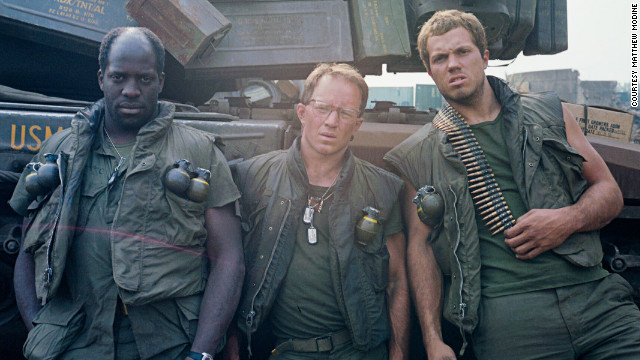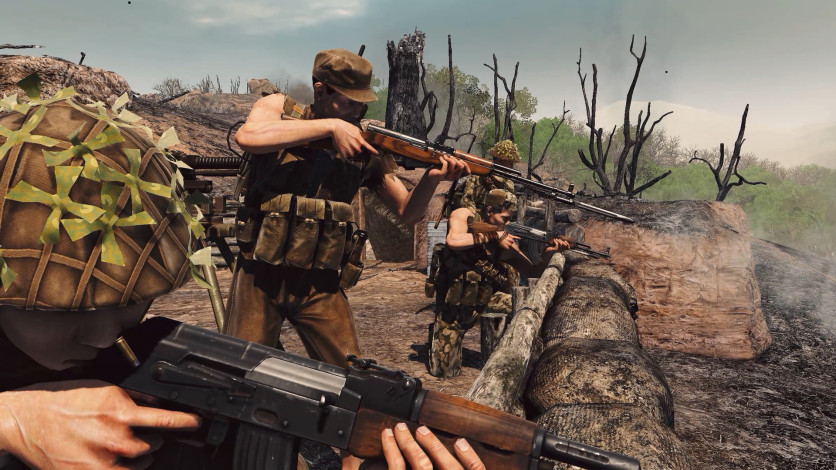Games based on the Vietnam War have generally been way shittier than they should be when you look at the subject matter. This is one of the most culturally-coded and vibrantly (if horrifically) remembered conflicts, that took place during an explosion of new styles in visual and commercial art, popular music, and has within it a common archetype that our society has fallen over itself to mythologize time and again ever since- the nihilist academic soldier, who knows everything but believes in nothing. Joker, from Full Metal Jacket, basically. He just wants to get out alive from a war he doesn’t understand, willingly or otherwise.
Joker has evolved since Full Metal Jacket came out, especially in video games. For one, Joker was pretty well-rounded as a character, and very cerebral. Video games are only getting cerebral in the last decade or so, and there hasn’t been much place for the reason we actually like Joker- he makes jokes and references to highlight the absurdity of war, especially the Vietnam war. Naturally, highlighting the absurdity of war doesn’t have much place in a game how about how fun it is to simulate the horror of young men trying to murder each other as efficiently as possible.

I’m not trying to get on a soapbox here; I like Battlefield, I like Call of Duty (sometimes). I like war games. We’ve been playing at war since before we had video games to simulate trenches and AK-47s in 4k headsets with motion-controllers shaped like pistol grips, because war is the most dramatic, romantic thing our lizard brains can conjure up. All of the mythic archetypes in our collective unconscious are amplified by a thousand because we have the greatest Earthly task we can imagine before us, and an obstacle that has a good chance of killing any one of us, as individuals. War is a great reductionist; it’s literally kill-or-be-killed. There’s no time to mince words, to examine loyalties. There’s just no time. It makes morality simple. Naturally, war is a great playground for storytelling, and it has been since whichever of those things came first.
So video games and war are a natural fit, video games being short stories, usually, and war being so fertile a ground for stories to be told. Video games rarely explore much of the potential of a good story, though, so there isn’t much place for Joker’s nihilism about the meaning of war. His jokes, though, his cultural references, his blasé attitude about death and napalm have stuck around, because they’re entertaining. They’re good at turning horrible wars into fun, adventurist narratives.
But the same way video game developers have fundamentally misunderstood or misinterpreted Joker, they’ve misinterpreted Vietnam, and the games they’ve made have suffered for it. Vietnam was the first time American soldiers faced long-term asymmetric warfare, and games set within it have rarely represented this very well. In single-player games, you’re always the Americans, which goes against a lot of what we fundamentally love about our favorite story: we’re not the underdogs. We’re not Han Solo, we’re the Stormtroopers. Our stormtroopers have cool slogans scrawled on their helmets, but they’re still the stormtroopers. Unless our nationalism can supersede our instinctual urge to favor the unfavored, we’re rooting for the wrong team.

Multiplayer Vietnam games try and get around this by removing the narrative, and thus, the really obvious moral component. But that underdog-vs-the-favored dynamic should still be there, and games tend to fail when they don’t play up the asymmetry of the two factions enough. There’s a reason they do this. Either the developers are lazy about trying to balance two radically-different methodologies of play, or they’re afraid of the PR conundrum of marketing a game to Americans where their own grandparents feel like the bad guys bringing enormous guns and helicopters and chewing gum to rice paddy villages, in an effort to uphold the French colonial empire against the oppressed, plucky little rebels.

Rising Storm 2: Vietnam does a little better in this regard than a lot of games. There are the obvious differences between playing as US Army or Marines vs the two Vietnames factions: different weapons and character models. Rising Storm one-ups most of its predecessors immediately and takes away the Vietnames faction’s vehicles. The only vehicle the players get to actually control in-game are Huey helicopters or some kind of attack helicopter, and both are only available to the Americans. There’s also an AC-130 gunship that sprays minigun bullets all over a point dictated by the American team’s commander, napalm airstrikes, and Bird-dog scout planes. They’re all loud and in-your-face, and facilitate more of the general style of play war games want you to use: blow up the enemies in the open, smoke out the campers, then move in and clean up. American characters can spawn on their squad leaders as long as those SLs stay alive, forcing a more cautious approach to actually fighting. Losing your squad leader on an objective can fuck up fifteen minutes’ of pushing the Vietnamese forces off the point.

The Vietnamese answer to this set of tactics are pretty cool. They have traps, of course, although they’re not very effective in practice- most of them are very situational, and its hard to put them anywhere where an American players will actually trip it before a random grenade or airstrike blows it up. Maybe the best tool in the Vietnamese factions’ arsenals are the squad leaders’ abilities to place spawn tunnels around the map, letting them continuously flank the American team, widen front lines, and wipe out the American squad leaders. The Vietnamese squad leaders don’t need to stay alive for their squad to keep the convenient spawn, they just need to hide their tunnel. In another game this would be a huge advantage for the Vietnamese forces since they don’t need to be careful, but suicidal charges in Rising Storm 2 are as effective as they were in Rising Storm 1: not at all. You don’t get to find out where that sniper shot you from every time he kills you. You don’t get to eat 3 bullets and still toss your grenade at the machine gunner. Both teams need to be careful, just in different ways.

I think there’s more room for asymmetry that Tripwire Interactive could have used to push the envelope; some maps have pre-built Vietnamese tunnels, for instance but they almost never see any action because they favor the Vietnamese too much in a fight inside the tunnels but rarely lead anywhere especially useful for the Vietnamese team to bother with them. The traps could be better. It’s all a balancing act, though, and Tripwire Interactive walks it very well. Playing either side feels very, very different from the other, each individual character has a lot of freedom to excel or fail, and it all feels brutally balanced.
None of this is revolutionary or exceedingly original, but its compiled in a well-oiled package that succeeds where most attempts have failed. It’s a progression from what Tripwire Interactive has been doing since Red Orchestra 2, and in that context, its a great success. Its more accessible than that game or the Rising Storm expansion for it, but still more complex in how the mechanics of the different factions interact. Most importantly, though, if you had the patience for either of the games that came before it, Rising Storm 2 is really goddamn fun. You should buy it.

I have just set up a blog doing game reviews I hope you don’t think I’m being foward when I ask do you have any advice
LikeLike